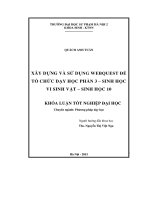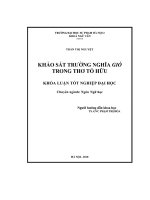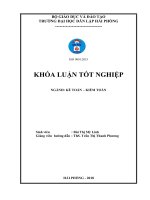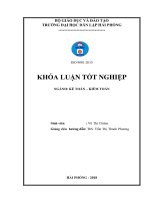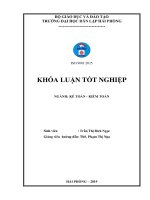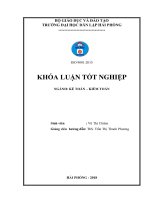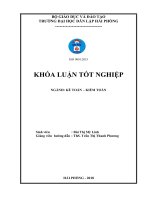Khóa luận tốt nghiệp techniques for translating advertising slogans from english to vietnamese
Bạn đang xem bản rút gọn của tài liệu. Xem và tải ngay bản đầy đủ của tài liệu tại đây (932.38 KB, 74 trang )
VIET NAM NATIONAL UNIVERSITY OF AGRICULTURE
FACULTY OF EDUCATION AND FOREIGN LANGUAGES
BA THESIS
TECHNIQUES FOR TRANSLATING ADVERTISING
SLOGANS FROM ENGLISH TO VIETNAMESE
NHỮNG KĨ THUẬT TRONG DỊCH KHẨU HIỆU
QUẢNG CÁO TỪ TIẾNG ANH SANG TIẾNG VIỆT
Student
:BUI THI THUY
Student code
:621210
Major
:ENGLISH
Supervisor
:TRAN THI TUYET MAI, M.A.
HaNoi - 2021
VIET NAM NATIONAL UNIVERSITY OF AGRICULTURE
FACULTY OF EDUCATION AND FOREIGN LANGUAGES
BA THESIS
TECHNIQUES FOR TRANSLATING ADVERTISING
SLOGANS FROM ENGLISH TO VIETNAMESE
NHỮNG KĨ THUẬT TRONG DỊCH KHẨU HIỆU
QUẢNG CÁO TỪ TIẾNG ANH SANG TIẾNG VIỆT
Student
:BUI THI THUY
Student code
:621210
Major
:ENGLISH
Supervisor
:TRAN THI TUYET MAI, M.A.
HaNoi - 2021
CERTIFICATE OF ORIGINALITY
I, the undersigned, hereby certify my authority of the study project report entitled
Techniques for translating advertising slogans from English to Vietnamese
submitted in partial fulfillment of the requirements for the degree of Bachelor in
English Language. Except where the reference is indicated, no other person’s work
has been used without due acknowledgement in the text of the thesis.
Hanoi, 202...
Bui Thi Thuy
Approved by
SUPERVISOR
(Signature and full name)
Date:……………………..
i
ACKNOWLEDGEMENT
Implementing a graduation thesis is the most important stage in every
student's life. The graduation thesis is a premise to equip me with research skills
and valuable knowledge before starting a career. Graduation thesis with the topic
"Techniques for translating advertising slogans from English to Vietnamese" is the
result of my ceaseless efforts and the enthusiastic help and encouragement of
teachers, friends and relatives.
First of all, I would like to express my sincere appreciation and gratitude to
M.A Tran Thi Tuyet Mai for her wholeheartedly helping and orienting the way of
thinking and working in science. Those are very precious comments not only in the
process of implementing this thesis, but also as a luggage for me in the process of
studying and establishing my career in the future.
I would like to sincerely thank all teachers of Vietnam National University of
Agriculture. Especially the teachers of the Faculty of education and foreign
languages, who have provided me with not only knowledge during my student life
but also their useful advice for me to be able to complete this graduation paper. I
would also like to extend my gratitude to all the authors of the books and materials
listed in the reference part for their worthy information and ideas that have been
reflected and developed in the study.
And finally, thanks family, friends, K62ENGA class for always being there,
supporting and encouraging during these stressful and difficult moments.
Thanks again to all who helped me.
Hanoi,.………2021
ii
TABLE OF CONTENTS
CERTIFICATE OF ORIGINALITY
i
ACKNOWLEDGEMENT
ii
TABLE OF CONTENTS
iii
ABSTRACT
v
LIST OF ABBREVIATION
vi
LIST OF TABLES AND FIGURES
vii
PART ONE: INTRODUCTION
1
1. Rationale
1
2. Aims and objectives of the study
2
3. Research question
2
4. Scope of the study
3
5. Significance of the study
3
6. Design of the study
3
PART TWO: DEVELOPMENT
5
Chapter 1. LITERATURE REVIEW
5
1.1. REVIEW OF THE PREVIOUS STUDIES (AT HOME & ABROAD)
5
1.2. REVIEW OF THEORETICAL BACKGROUND
7
1.2.1. Translation theory
7
1.2.2. Advertising and Advertising Slogan Theory
14
1.2.3. Summary
28
Chapter 2: METHODOLOGY
29
2.1 RESEARCH GOVERNING ORIENTATION
29
2.1.1. Research questions
29
2.1.2. Research hypothesis
29
iii
2.1.3. Research Types
29
2.1.4. Research Approaches
29
2.1.5. Principles/Criteria for data collection and data analysis
29
2.2. RESEARCH METHODS
31
2.2.1. Major Method
31
2.2.2. Supporting Method
31
2.3. SUMMARY
31
Chapter 3: FINDINGS AND DISCUSSION
33
3.1. SOME ADS SLOGANS AND THEIR EQUIVALENTS
33
3.2. USEFUL TECHNIQUES FOR TRANSLATING ENGLISH ADVERTISING
SLOGANS INTO VIETNAMESE
52
3.2.1. Translating by Literal Translation
53
3.2.2. Translation by Equivalence
54
3.2.3. Translation by Adaptation
55
3.2.4. Translation by Modulation
56
3.2.5. Non-Translation
57
3.3. SUMMARY
57
Part III: CONCLUSION
58
1. Recapitulation
58
2. Concluding remarks on each of the thesis objectives
59
3. Limitation of the current research
59
4. Suggestions for further research
60
REFERENCES
61
APPENDIX
63
iv
ABSTRACT
An effective brand identity system is the first factor and also the prerequisite
for building a strong brand image. Brand positioning statement (slogan) is a very
important tool in the brand identity system to help the brand "flirt" effectively to
consumers. Wrong translations may have severe consequences if they come out in
company communication. It may influence the company image and bottom line
negatively. From that, techniques for translating ads slogans to help translators will
be presented. This study first gives theoretical background about translation
including its definition, translation procedure, translation techniques, definition of
ads and ads slogan. The main goal of this study is find out the useful techniques
applied in translating English ads slogans into Vietnamese. Besides, this paper also
goes further into definition and characteristics of ads and ads slogan to give
background knowledge about these ones before having a deep analysis about the
principle linguistic of ads slogans language, such main features of advertising
language as phonological, lexical and morphological, syntactic and lastly semantic
levels were introduced and techniques for translating ads slogans from English to
Vietnamese have been carried out. Both qualitative and quantitative methods are
applied in this study. This result points out that there are four translation techniques
including equivalence, literal, adaptation, modulation are applied in EnglishVietnamese translation of ads slogans are the most useful techniques and some
slogans are non-translated.
Although there are some limitations remaining in this study, hopefully, this
study will be a valuable study that not only helps translators recognize gaps in their
English advertising slogans translating techniques, but also helps those who are
passionate about translating English advertising slogans to translate intelligently
and effectively.
v
LIST OF ABBREVIATION
Ads: Advertising
TL: Target Language
SL: Source Language
L:
Literal
E:
Equivalence
B:
Borrowing
M:
Modulation
C:
Calque
T:
Transposition
A:
Adaptation
vi
LIST OF TABLES AND FIGURES
Table 01: The Translation techniques used in Translating English Advertisement
Slogans into Vietnamese based on Vinay and Darbelnet Translation Model ........ 49
Table 02: Frequency of Translation Techniques Used in Translating English
Advertising Slogans into Vietnamese ................................................................... 51
vii
PART ONE: INTRODUCTION
1. Rationale
Nowadays, with the proliferation of the market economy, as well as the
increasing needs and demands of customers, all business and companies have to
make efforts to promote and create great influence on customers. Mr Kumail
Hemani said that:” Creating a prominent identify is what every brand desire and so
getting an extra identify is surely a bonus. Slogan is embroidered with brand name
and has ubiquitous presences along with it…so it technically works as a shadow for
brand name”. It is crystal clear that most companies have their own advertising
slogans and brand names to bring their products closer to the public. The results of
this marketing make it easier for customers to know what name of this product is,
how quality it is. It is not difficult to recognize the slogan as an advertising trend in
the future. Thus, it is not surprising that most of these companies use alliteration,
puns and extended semantics which are almost mandatory in advertising slogans.
While verbal humor, puns… can add to the novelty of an advertisement, extended
meaning (also known as figurative meaning) is unlikely to be translated into
another language. Therefore, many humorous translations were born. When
entering the Vietnamese market, international brands usually already have all the
promotional materials and communication available. Therefore, the translators’ job
is simply to rely on that material to perceive the brand identity and translate it. But
the translation here is not merely a purely literal translation, but must convey the
true spirit of the slogan.
Personally, in the process of learning I am fascinated by advertising slogans
which might comprise the organizational image and brand’s spirit as well as some
inquisitive about the picture of language, the creative use of words in ad slogans. I
also found out a variety scope of interesting situations of mistranslating or failure
1
translation in reality. Besides, I have learnt many translation techniques during
school. However, each field has its own effective techniques. Hence, how to do
well this creative transfer is still a question. As a matter of fact, translating is not an
easy work, especially in translating advertising slogans. The question occurred is
that whether there are any techniques, rules,….are useful to solve those difficulties.
Transposition, Adaptation and Free translation work effectively or not in
transmitting English ad slogans into Vietnamese.
Furthermore, advertising slogans translation is exquisite and perceptive. The
aspects of attractiveness, message, spirit, elegance of expression, faithfulness is
needed to be transferred. It is difficult to transmit these aspects. But there are a few
research and satisfied studies to figure out useful techniques for translating
advertising slogans into Vietnamese. Thereby, my research is contributive to give
a deep insight of the area and create a premise to study some useful techniques
applicable to translating the advertising slogans as well as helping Vietnamese
people learn English to recognize interesting characteristics in English
advertisement in order to identify more accurately and apply in practice and from
that be able to choose interpretations from an advertising slogan English to
Vietnamese and vice versa reasonably and exactly.
2. Aims and objectives of the study
The study aims to find out the techniques that are used to translate slogans
from English into Vietnamese. In order to fulfill this task, linguistic features of
famous advertising slogans will be analyzed. At the same time, the translation
versions of these slogans will also be examined.
3. Research question
To reach the aims within the scope, the research questions below are solved:
2
-what are the typical linguistic features of the English advertising slogans?
-what are useful techniques for translating advertising slogans from English
into Vietnamese?
4. Scope of the study
My research paper includes the study of linguistics features and techniques
used in translating 30 well-known advertising slogans which are collected from
newspapers, magazines, the internet….
5. Significance of the study
Wrong translations affecting brands. People will tend to remember the ‘funny’
translation for a long time. Making a good translation is essentially not an easy
task. It is not just translating word for word. Professional translators are trained to
consider all the aspects needed to make a translation work. Successful translation is
a means to magnetize customers and make a strong appearance for a company. It is
never an easy work. That is why this study is shepherded to discuss the techniques
that translators usually use in the advertising slogans translating process and to
come up with some useful techniques for translating English advertising slogans
from English into Vietnamese.
6. Design of the study
This research is divided into three primary parts:
Part I: Introduction presents rationale for the study, Aims and objectives of the
study, Research questions, Scope of the study, Significance and Design of the
study.
Part II: Development consists of 3 chapters
3
Chapter 2.1. Literature review comprises Review of the previous studies and
Review of theoretical background (This chapter states the theories of translation,
advertising and advertising slogans including translation definition, translation
procedure and translation techniques, …)
Chapter 2.2: namely Methodology will present the research methodology, research
setting, data collection and data analysis.
Chapter 2.3 is Findings and Discussion that will suggest useful techniques for
translating advertising form English to Vietnamese.
Part III: Conclusion will provide some references related to this study and
appendix.
4
PART TWO: DEVELOPMENT
Chapter 1. LITERATURE REVIEW
1.1. REVIEW OF THE PREVIOUS STUDIES (AT HOME & ABROAD)
When it comes to business, having own distinct brand is essential. Aside from
the logo, the slogan - also known as a commercial slogan - is regarded as one of the
most effective tools for making a lasting impression on customers. One of the
brand positioning forms of the company in mind of customers is to give a tiptop
and extraordinary advertising slogan for its brand. So, it is no surprise that
advertising slogans has become a field of specialization and advertising translation
has rapidly been expanded in professional practice as well as in the curricula of
translators and has become one of the most dialectical researches in translation
studies. Here are some famous titles that can be mentioned:
Firstly, according to a research which was studied in “Các khó khăn về ngơn
ngữ trong q trình biên dịch quảng cáo cung cấp thơng tin của sinh viên năm cuối
chuyên ngành biên-phiên dịch tiếng anh, trường Đại học Cần Thơ - Linguistic
difficulties
in
translating
informative
advertisements
faced
by
English
Interpretation - Translation seniors at Can Tho University” which was fulfilled by
Nguyen Van Phuc and Truong Thi Ngoc Diep. This study describes the students'
ability to translate informative advertisements by investigating their perceptions of
linguistic difficulties in translation practice as well as the linguistic difficulties they
actually encountered. However, this research just focus on vocabulary and
grammar but linguistic at 4 level such as: phonological, semantic,… that needed
more comprehensive analysis. Consequently, this problem will be discussed
carefully in this study. Moreover, in this following study, branches of other
techniques are going to be deeper explained with specific examples particular in
5
translating advertising slogans from English to Vietnamese that help students to
deal with linguistic difficulties.
Another research was carried out by Phan Thi Van Anh with the supervisor is
Assoc. Prof. Dr. Le Hung Tien which was studied in “Difficulties and strategies in
English-Vietnamese translation of advertising slogans”. In this study, the researcher
presented issues affecting the translation process and a set of different
characteristics and features of the advertising slogans and popular translating
tendencies, useful strategies as well as common problems or difficulties in EnglishVietnamese translation. However, this study did not pay more attention to culture
element in translating ads slogans. In order to have a full picture of ad slogans
translation, this research will continue with culture element and a deeper study on
techniques for translating advertising slogans from English to Vietnamese.
Besides, Lavinia Dan (Nădrag) in the study called Techniques for the
translation of advertising slogans. The study presents the translation of culturebound elements in ads slogan translation. The researcher also gave some useful
techniques like adaptation, paraphrase or literal translation. But my study will give
translators some useful techniques for translating ads slogans from English into
Vietnamese base on the translation techniques model of Vinay and Darbelnet
(1995).
The study on The Challenges of Translating Advertisements and Slogans was
studied by Komljenović, Ana. The study of advertisement translations based on the
strategies used to translate advertisements and slogans. In that study, the researcher
did not give the translation theory for readers. In addition, that study lacks of the
linguistics features in advertising slogans which is a challenge for translators. This
research will be continued with a deep study of linguistic features in order to obtain
a complete picture of ad slogan translation.
6
1.2. REVIEW OF THEORETICAL BACKGROUND
This section is divided into two parts, the first of which reviews translation
theories, such as the concept of translations, translation procedure, translation
techniques and the second of which presents a general understanding of advertising
concepts as well as advertising slogans and culture element in translating
advertising slogans.
1.2.1. Translation theory
1.2.1.1. Translation definition
According to John Catford (1917-2005) “Translation is defined as
unidirectional (SL=>TL) and is a replacement of textual material in one language
(SL) by equivalent textual material in another language (TL), it explains, then, that
translating is not always about finding the equivalent (structure, grammar, lexis ..
etc) but sometimes, it’s about replacing the text material by a non-equivalent one,
and in other cases, is but a simple transference of SL material into the TL material”
(p.20). Because of its prominence, translation has been viewed in a variety of ways.
There are many definitions around this.
By Bui Tien Bao and Dang Xuan Thu, translation is rendering a written text
into another language in a way that the author intended the text. Translators are
concerned with the written word. They render written texts from one language into
another. Translators are required to undertake assignments, which range from
simple items, such as birth certificates and driving licenses, to more complex
written materials, such as articles in specialized professional journals, business
contracts and legal documents.”
By dictionary Merriam-Webster 1974 definition translation is basically a
change of form (change from one state or form to another to turn into one’s own or
another language).
7
Newmark defines translation as “a craft consisting in the attempt to replace a
written message and/or a statement in one language by the same message and or
statement in another language” in his book A Text book of Translation.
As can be seen, there are many different definitions about “translation”.
There’s a growing body of deep study and comprehensive development of this
concept. Although there are numerous definitions about this. Almost all of them
share the same idea that translation is a linguistic phenomenon or a process of
transferring the meaning of the source language text into the receptor language text
between two different languages. In this process, the language to be transferred is
called “Source Language” (SL) whereas the language to be transferred into
translation is called “Target Language” (TL). Translation has its own distinction
and its own interest. There are always successful translations. But there is no such
thing as a perfect, ideal or “correct” translation.
1.2.1.2. Translation procedure
The translation procedures are depicted by Nida (1964) as follow:
Technical procedures
This procedure is the analysis of the source language and target languages as well
as a comprehensive understanding of the source language before the start of
translation.
Organizational procedures
This procedure is a regular re-evaluation of the translation. This work also
includes comparing the current translation with the relevant translations of other
translators. In addition, the organizational procedure also checks the effectiveness
of conveying in translation through collecting comments from readers of the source
language in order to evaluate the accuracy and effectiveness of the translation as
well as the readers’ response.
8
1.2.1.3. Translation Techniques
Vinay and Darbelnet stated that translation procedures are applied for
sentences and smaller units of language within that text. Vinay and Darbelnet
analysis equivalence-oriented translation as a procedure which “replicates the same
situation as in the original, whilst using completely different wording” (1995,
p.342). They also reveal that if this procedure is used during the translation process,
it can retain the stylistic effect of the source language in the target language.
Translation techniques is a specific verbal equivalence procedure for translators.
Translation techniques are derived into 2 categories: Direct translation techniques
and oblique translation techniques. When the conceptual and structural elements of
the source language (SL) are directly transferable into the target language, direct
translation techniques are used (TL). Borrowing, calque, and literal translation are
the techniques used in direct translation. Oblique translation techniques are used
when the conceptual or structural elements of the source language cannot be
directly translated into the target language without changing its stylistic and
grammatical elements, as well as the meaning. The translator has tighter and
stricter control over their translation in this case. There are five types in this
category.
a) Direct translation techniques
- Borrowing
Borrowing is a popular translation technique. It is a translation technique that
concerns using the same word or expression in the target language as it is found in
the source language. Numerous English words are “borrowed” into other
languages; in contrast, English also borrows a lot of words from other languages.
For instance: entrepreneur, café, ballet and résumé from French; waltz and
rucksack from German; plaza from Spanish and tofu from China; etc. In the case of
9
filling a semantic gap (e.g., a new technique, an unknown concept) then the
borrowed translation method is the simplest of all. In particular, such words as
“pajamas” or catwalk can easily be seen on the newspaper in Vietnam without any
change to the form and the meaning of the words or changes in form but no change
in meaning and sometimes combine the two types. Many such words become part
of the lexis of the borrowing language without appearance as loans.
For examples:
email -> email, internet -> internet (borrowing does not change in form and
meaning)
canteen -> căn tin (borrowing changes in form but no change in meaning)
ozone layer -> tầng ô-zôn (combine the two types above)
- Calque
In linguistics, a calque or loan translation or “through translation” as
Newmark (1981:30) calls it, is truly a word or phrase borrowed from another
language and translated literally. When using calque translation technique,
translators tend to create a new word in the target language but still keep the
structure of the source language. Calquing is different from phono-semantic
matching. While calquing includes semantic translation, it does not comprise
phonetic matching (i.e. preserving the approximate sound of the borrowed word
through coordinating it with a similar-sounding pre-existing word or morpheme in
the TL).
For example:
heavy industry -> cơng nghiệp nặng
showroom -> phịng trưng bày
There are four types of calque posted on March 13, 2009, by Scott J:
10
• Paronymous calque or borrowed word: This is due to an incorrect
correspondence between two words that have similar etymologies or forms but
have evolved differently in their respective languages, so that they now have
different meanings. It can happen when two words in English are etymologically
related but have a slight difference in meaning, and the irrelevant one is chosen.
• Orthographic calque: This is commonly seen in the transliteration of people's,
places', and ethnicities' names. Writing and spelling conventions of the SL that
make little or no sense in the TL are copied carelessly.
• Typographic calque: This occurs when only the source language's
typographical conventions are transferred to the new language. For example, the
use of capital letters in the English language, as well as the use of certain quotation
marks and italics for emphasis, has begun to creep into the Spanish language.
• Syntactic or structural calque: This is the result of an incorrect connection
between sentence or phrase elements. It introduces a new structure into the
language.
/>- Literal translation
Literal translation is the replacement of the syntactic structure of the original
language, usually sentences or clauses with the same or almost identical syntax.
The translator does not need to make the changes except for the changes required
by the grammar of the translation language itself. This technique is described by
Vinay and Darbelnet in “Translation Procedures” (p. 61-69) as the most common
between languages with the same genealogy and culture. It is necessary to
understand it here as a technique rather than a type of translation. This happens
when there is an exact structural, lexical, even morphological equivalence between
11
two languages. This enables only when the two languages are very close to each
other.
For example:
- She is deaf to all his advice.
-> Cô ta bỏ mặc tất cả những lời khuyên của anh ấy.
In brief, sometimes it works, and sometimes it does not: If one sentence can be
translated literally across language, it does not mean that all sentences can be
translated literally. In general, literal translation is often associated with scientific,
technical, technological or legal texts.
b) Indirect (Oblique) translation techniques
- Transposition
It operates at the grammatical level, and it comprises the replacement of a
word class by another word class without changing the meaning. The transposition
is not only occurring between two verbs and nouns, but also between other part of
speech. The transposed expression does not have the same stylistic value, but the
meaning is the same. Transposed expressions are usually more literary in character.
For example:
Reconstruction of the district is very important.
Reconstructing the district is very important.
To reconstruct the district is very important.
In other words, transposition is the mechanical process by which parts of
speech change their order when translated. In some ways, this is a change in word
class.
- Modulation
12
Modulation is the use of a phrase that differs in the source and target
languages to convey the same idea. Modulation refers to a change in a message as a
result of a shift in one's point of view. It is about altering the form of the text by
introducing a semantic shift or a new point of view. It is used when other
techniques may result in grammatically correct but inappropriate, non-idiomatic, or
awkward utterances in the TL. Modulation is a technique used by translators to
create accurate and idiomatic translations. In short, this technique leads to a
solution that clarifies the meaning, identifies the natural aspect in the receptor's
language, and so on.
- Reformulation or Equivalence
This method refers to situations where two languages together describe a
situation but with different structural or stylistic. This is used to express something
in a completely different way such as idioms, proverbs, nominal or advertising
slogans translation. When translating ads slogans, interjections, proverbs,
institutional names, and idioms, the expression must often be translated in a
completely different way. Equivalence or reformulation are used in this case. This
is a difficult process in which creativity is required. For example, the phrase "don't
put all your eggs in one basket" is easily understood by Americans and other
English speakers. However, directly translating this phrase may not have the same
meaning in other languages, so replacing it with the phrase “keep your options
open” makes it easier to understand in more languages.
For example:
The dearest is the cheapest. -> Của rẻ là của ôi.
It’s finger lickin’s good (KFC slogan) -> Vị ngon trên từng ngón tay.
13
This technique is inventive, but it is not always simple. As a result, the
demand for creating equivalences arises from the situation, and it is in the context
of the SL text that translators must seek a solution.
- Adaptation
This is the last technique to be used when a situation in the original culture
does not exist in the translation culture so there must be a facility equivalent to the
original culture in the translation culture or this is used when a culturally specific
term or phrase is translated in a completely different way so that it becomes
appropriate or familiar in the language of another culture. The adaptation technique
can be described as a special equivalence or situational equivalent. It consists of
modifying the concept, or using a situation analogous to the SL situation though
not identical to it. This is the original rewriting form in the translated language,
mainly used for the translation of poems, songs and plays.
For example:
For whom the Bell Tolls (novel) -> “ Chuông nguyện hồn ai” in Vietnamese.
Home Alone (film) -> means “Ở nhà một mình” but in Russia, it means “ Mẹ
ơi con lỡ chuyến bay rồi”.
1.2.2. Advertising and Advertising Slogan Theory
To do research into ads slogans, first of all, the learners must understand what
an advertising and ads slogan are. Different people hold the different opinions on
the definition of English ads slogan; they have the different view on the definition
of English ads slogan. Although there are many concepts of ads slogan, in the
scope of this study, I only mention some concepts in English and Vietnamese. This
part of the study also will bring the general and basic ideas of ads and slogans
which are essential for understanding the issue as a whole.
14
1.2.2.1. Advertising
Advertising is a form of ownership of the most powerful tool in Marketing
Ads. The goal of this form is to send customers the message that the business wants
to convey. The message here is simply understood as the unique and different
values of the product that are repeated at high frequency. On media (newspaper,
radio, TV, billboard, ...) in order to attract the attention of consumers, come into
mind and then motivate them to buy products.
By Meriam – Webster, advertising as the action of calling something to the
attention of the public especially by paid announcements
By Cambridge dictionary, it is the business of trying to persuade people to buy
products or services.
By Susan Ward, “Advertising is the attempt to influence the buying behavior
of customers or clients with a persuasive selling message about products and/or
services. In business, the goal of advertising is to attract new customers by defining
the target market and reaching out to them with an effective ad campaign”.
( )
“Advertising is a means of communication with the users of a product or
service. Advertisements are messages paid for by those who send them and are
intended to inform or influence people who receive them”, as defined by the
Advertising Association of the UK. The ads industry is made of companies that
advertise, agencies that create the advertisements, media that carries the ads, and a
host of people like copy editors, visualizers, brand managers, researchers, creative
heads and designers who take it the last mile to the customer or receiver.
Advertising is not just about the commercial promotion of branched products but
can also encompass the idea of texts whose intention is to enhance the image of an
individual, group or organization.
15
1.2.2.2. Slogan and advertising slogan
a) Definition of slogan and advertising slogan
Slogan is a trade slogan, the old meaning of the pre-battle cry of Scottish
warriors. Nowadays, the slogan is understood as the brand name of a company. A
slogan is often considered part of a company’s intangible assets even though it is
just a saying. To have a good slogan, in addition to investment in brainpower, there
must be continuous investment in advertising with long-term strategies. Therefore,
when having a slogan that stands in the minds of customers, it has become an
invaluable asset nurtured by time, money and the company’s reputation.
According to Longman Dictionary of Contemporary English (1995: 1349), “a
slogan is a short easily-remembered phrase used by an advertiser, a politician, etc.”
Therefore, in general, a slogan is a memorable motto used in political, commercial,
religious, and other contexts as a repetitive expression of an idea or purpose. In the
particular case of an advertising slogan, it is a verbal logo normally appearing just
beneath or beside the brand name or the logo of the product. In other words, a
slogan is kind of a condensed message of the whole advertisement which
advertisers want their customers to remember most. It is the usual case that slogans
come to customers‟ mind first when they think about the products.
Manavi Pandey indicates Advertising slogans emphasize on a particular
product or service that has been part of an ad campaign, instead of focusing on the
overall business. It aims to create associations between the product’s usage
experiences and the benefit that the customer may receive after purchase.
( )
In this competitive world, the advertising slogan is a useful tool to increase
brand awareness and visibility in the consumer market. If done right, it can engage
directly with the target customer and communicate the right message. Brands are
16
